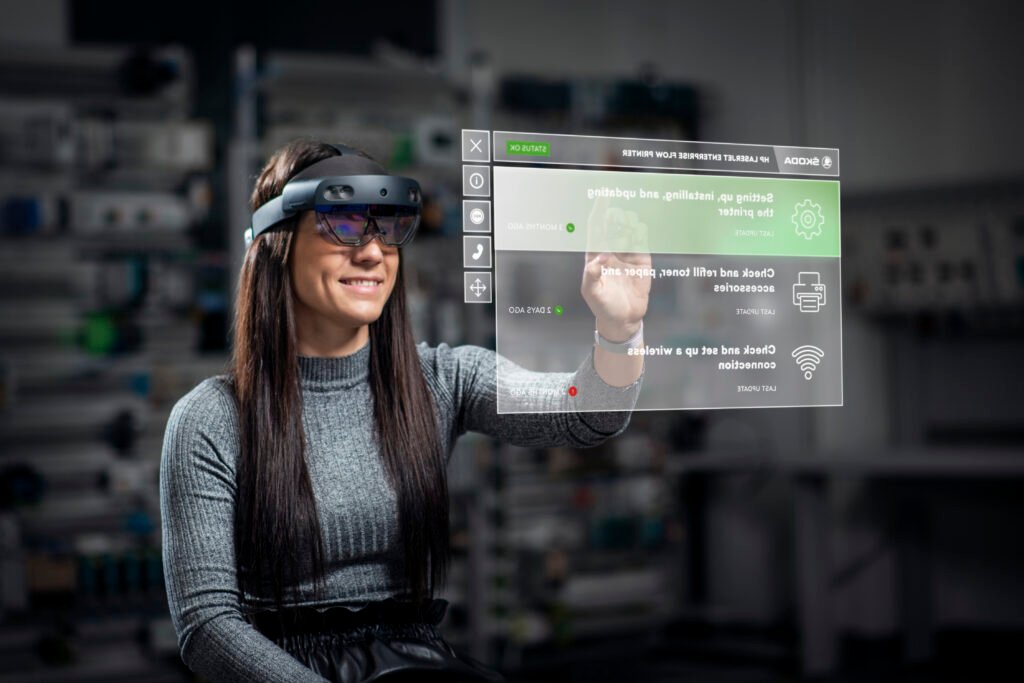In today’s dynamic digital landscape, businesses perpetually pursue inventive methods to captivate their audience. Augmented Reality (AR) emerges as a pioneering force in technological advancements, presenting an assortment of intriguing opportunities to overhaul marketing tactics. This in-depth guide intends to delve extensively into the realm of AR, unraveling its multifaceted applications that wield influence over marketing initiatives. By dissecting its diverse applications, this guide aims to illuminate the profound impact of AR and unravel the myriad dimensions of its transformative influence on contemporary marketing strategies.
The Rise of Augmented Reality in Marketing: A Paradigm Shift
Augmented Reality (AR) has undergone a rapid transformation, transitioning from a mere futuristic notion to a pivotal instrument that is fundamentally altering the marketing terrain. Its seamless integration of digital components into tangible, real-world settings has become a catalyst for a paradigm shift in marketing strategies. AR serves as a bridge, harmonizing the realms of physical and digital experiences, thereby cultivating unprecedented levels of interaction and immersive engagements. This revolutionary technology has opened boundless gateways of creativity, empowering brands to establish profound, more intimate connections with their audience, transcending traditional marketing approaches.
Technologies Used in AR Marketing
Augmented Reality (AR) marketing leverages several cutting-edge technologies to create immersive and engaging experiences for consumers. Some of the prominent technologies used in AR marketing include:
Computer Vision: AR relies on computer vision algorithms to recognize and interpret real-world images or objects. These algorithms enable AR applications to detect markers, track movements, and overlay digital content onto the physical environment accurately.
Simultaneous Localization and Mapping (SLAM): SLAM technology enables AR devices to map the physical surroundings in real time while tracking the device’s position within that environment. This helps in placing digital content precisely and maintaining its alignment within the user’s view.
3D Modeling and Rendering: Creating realistic 3D models and rendering high-quality visuals is crucial for AR experiences. Advanced 3D modeling software and rendering engines are used to design and develop lifelike digital objects that seamlessly integrate into the real world.
Sensors and Cameras: AR devices utilize a combination of sensors, including gyroscopes, accelerometers, and depth sensors, along with cameras to gather data about the user’s surroundings. These sensors help in understanding the environment and user movements for accurate AR content placement.
Mobile Devices and Smart Glasses: Most AR experiences are accessible through smartphones or tablets equipped with AR-enabled apps. Additionally, smart glasses and wearable devices offer hands-free AR experiences, overlaying digital information directly into the user’s field of vision.
Cloud Computing: AR applications often require substantial computational resources. Cloud-based AR platforms leverage remote servers to process complex data, enabling more sophisticated and resource-intensive AR experiences without overburdening the user’s device.
Artificial Intelligence (AI): AI technologies, such as machine learning and natural language processing, enhance AR capabilities by enabling personalized content delivery, real-time data analysis, and contextual understanding for more interactive and adaptive experiences.
Marker-Based AI: Marker-based AI, in the context of Augmented Reality (AR), refers to the utilization of artificial intelligence (AI) algorithms to detect and interpret specific markers or patterns within the physical environment. These markers act as triggers for AR applications, allowing them to recognize predefined images, symbols, or codes and overlay corresponding digital content onto these markers in real time.
The process typically involves the use of computer vision algorithms that enable AR systems to identify and track these markers accurately. Once detected, the AI algorithms interpret the markers’ position, orientation, and characteristics, facilitating the precise alignment and placement of virtual content over the recognized markers.
Marker-based AI in AR enhances the user experience by enabling interactive and contextually relevant digital overlays triggered by specific visual cues. This technology finds applications in various fields, including marketing, education, gaming, and industrial training, where it creates engaging and immersive experiences by seamlessly integrating digital elements into the physical world based on recognized markers.
Markerless AI: Markerless AR, a type of Augmented Reality (AR), doesn’t rely on specific markers or images for integrating virtual content into the physical environment. Unlike marker-based AR, which needs visual triggers, markerless AR utilizes advanced computer vision and simultaneous localization and mapping (SLAM) technology to place digital elements in real-world spaces without predefined markers. This approach uses cameras, sensors, and depth perception to analyze and map the environment, allowing virtual elements to be placed accurately on surfaces or spaces without the need for markers. Markerless AR enables versatile experiences in various fields like gaming, navigation, design, and more, creating immersive experiences without specific visual triggers.
Projection-based AI: Projection-based AR involves projecting digital content onto physical surfaces or objects in the real world. It functions by using projectors to display images, videos, or interactive content onto surfaces, creating an augmented experience. This form of AR doesn’t rely on screens or wearable devices. Instead, it projects digital information directly onto physical spaces, such as walls, floors, or objects. Projection-based AR finds applications in interactive exhibitions, entertainment, advertising, and immersive experiences, offering a unique way to blend virtual elements with the real environment.
Location-based AR: This type of AR utilizes location data from GPS, Wi-Fi, or cellular networks to superimpose digital content or information onto the user’s physical surroundings. It enables AR experiences based on a user’s specific location, providing location-specific information, navigation guidance, or location-triggered digital content.
Superimposition-based AR: This form of AR involves overlaying digital content directly onto the user’s view of the real world. It places virtual objects or information on top of what the user sees through a device’s camera, creating an augmented view of the physical environment.
Recognition-based AR: Also known as marker-based AR, recognition-based AR relies on specific markers or triggers, such as QR codes, images, or objects with predefined patterns, to recognize and augment digital content. When the device’s camera detects these markers, it triggers the display of associated digital content.
Sensor-based AR: Sensor-based AR utilizes various sensors present in smartphones or other devices, such as accelerometers, gyroscopes, or compasses, to augment digital information based on the device’s orientation, movement, or environmental conditions. This type of AR enhances user experiences by adapting digital content to real-world dynamics.
Web-based AR: Web-based AR operates directly within web browsers, allowing users to access augmented experiences without downloading dedicated apps. It enables the integration of AR elements into websites, providing interactive content and experiences accessible via a web browser on compatible devices.
These technologies work in synergy to create immersive AR marketing campaigns that engage users by overlaying digital content onto the physical world, offering interactive experiences, and enhancing consumer-brand interactions. As technology continues to evolve, the potential for innovative and impactful AR marketing experiences continues to expand.
Virtual Try-Ons: Redefining the Shopping Experience
Among the groundbreaking applications of Augmented Reality (AR) in marketing, virtual try-on experiences stand out as revolutionary. Consider the convenience of virtually donning clothing, accessories, or makeup, eradicating uncertainties linked with online shopping. AR-driven try-on encounters transcend the conventional e-commerce scene, elevating the entirety of the customer journey. These experiences instill a sense of confidence in consumers, enabling them to make well-informed purchase choices, ultimately reducing the frequency of product returns. As consumers interactively engage with products virtually, their confidence grows, leading to a more satisfying and informed shopping experience.
Interactive AR Experiences: Captivating Audiences in Real-Time
Augmented Reality’s (AR) essence revolves around its inherent interactivity, offering marketers a dynamic and versatile platform to enthrall audiences through inventive means. By integrating interactive elements into AR campaigns, such as gamification or 3D product demonstrations, marketers augment engagement levels while sustaining audience interest. These immersive encounters etch a memorable mark, nurturing robust brand-consumer connections and exerting a substantial influence on consumer purchasing behavior. The interactive nature of AR experiences not only captures attention but also cultivates a deeper engagement, prompting consumers to forge stronger connections with brands and positively impact their buying decisions.
AR-Powered Marketing Campaigns: A Winning Strategy
Effective marketing campaigns are distinguished by their resonance and enduring impact on audiences. Augmented Reality (AR) has surfaced as a potent tool for brands striving to distinguish themselves in the saturated digital landscape. Its integration not only serves as a testament to brand innovation but also positions businesses as trailblazing pioneers within their respective industries. By assimilating AR into marketing strategies, brands gain access to an expansive realm of creativity, allowing them to curate compelling campaigns that foster lasting brand recall and cultivate unwavering consumer loyalty. This adoption of AR elevates brand perception and sets businesses apart, showcasing their commitment to innovation and progressive approaches in engaging their audience.
Localization and Personalization:
Localization and personalization in the context of marketing refer to tailoring content, experiences, or campaigns to suit specific geographical regions, cultural nuances, or individual preferences of the target audience.
Localization involves adapting marketing content or strategies to resonate more effectively with audiences in different regions or countries. It goes beyond translation and considers cultural, linguistic, and regional aspects. For example, a global brand may localize its advertising campaigns by adjusting language, imagery, or messaging to align with the cultural sensitivities and preferences of diverse markets.
Personalization, on the other hand, focuses on customizing content or experiences at an individual level. It involves leveraging consumer data, such as browsing history, purchase behavior, or demographics, to deliver targeted and relevant content to each user. For instance, an e-commerce platform might use personalization to recommend products based on a user’s past purchases or browsing activity.
In marketing, combining localization and personalization strategies can enhance the effectiveness of campaigns by ensuring that content not only speaks the language of the audience but also resonates with their specific interests, behaviors, and cultural backgrounds. This approach leads to more meaningful and engaging interactions, ultimately driving higher engagement and conversion rates.
The Future of AR in Marketing: Trends to Watch
Continuing technological progress heralds limitless prospects for Augmented Reality (AR) in marketing. Emerging trends, like AR-driven social media filters and location-based marketing initiatives, unveil fresh pathways for marketers to traverse. Remaining attuned to these burgeoning trends empowers businesses to not just adapt but innovate their marketing strategies. This vigilance ensures that brands stay aligned with ever-evolving consumer preferences, enabling them to embrace novel approaches that resonate effectively with their target audience. The evolution of AR in marketing presents an ongoing opportunity for brands to stay ahead of the curve and dynamically engage with their consumers in innovative and relevant ways.
Conclusion: Embrace the AR Revolution
The integration of AR in marketing transcends mere trendiness; it signifies a revolution in consumer engagement and brand interactions. Virtual try-ons and interactive AR experiences redefine consumer-brand interactions, fostering immersive connections that endure. By adopting AR as a core component of marketing strategies, businesses not only distinguish themselves but also demonstrate a commitment to delivering cutting-edge experiences for their audience.
As the digital landscape evolves, AR will undoubtedly continue to shape the trajectory of marketing strategies. Embracing this technology unlocks endless possibilities, transforming how brands connect and resonate with their audience. The AR revolution is not just an opportunity but a necessity in navigating the dynamic and competitive market landscape.
Transform your marketing strategy with the unparalleled power of Augmented Reality. Discover our range of interactive AR experiences, revolutionizing how you connect and engage with your audience. Embrace the AR revolution today and witness your brand’s elevation in the digital realm.
This expanded exploration elaborates on the multifaceted aspects of Augmented Reality in marketing, emphasizing its diverse applications, significance, and future implications for businesses aiming to excel in the ever-evolving digital landscape.




